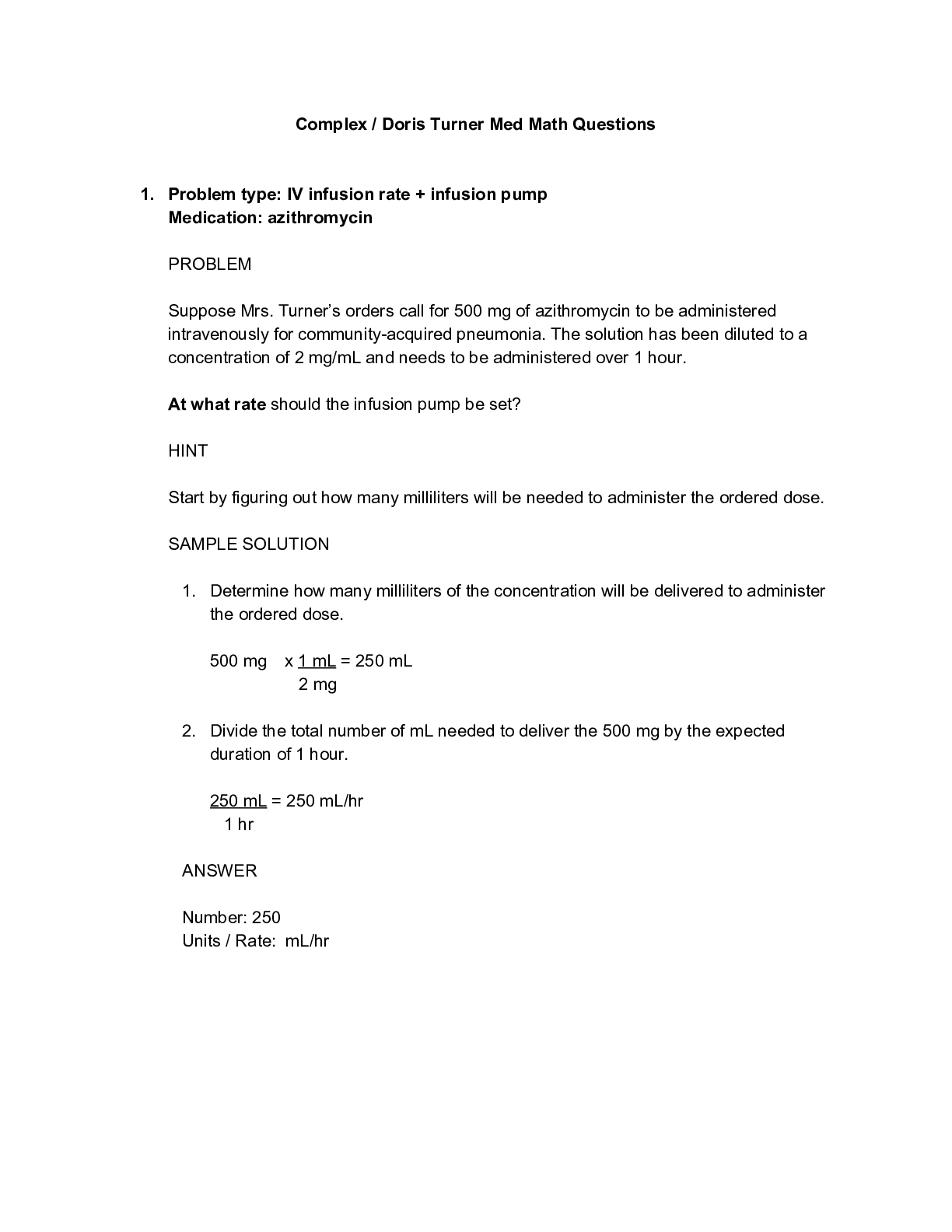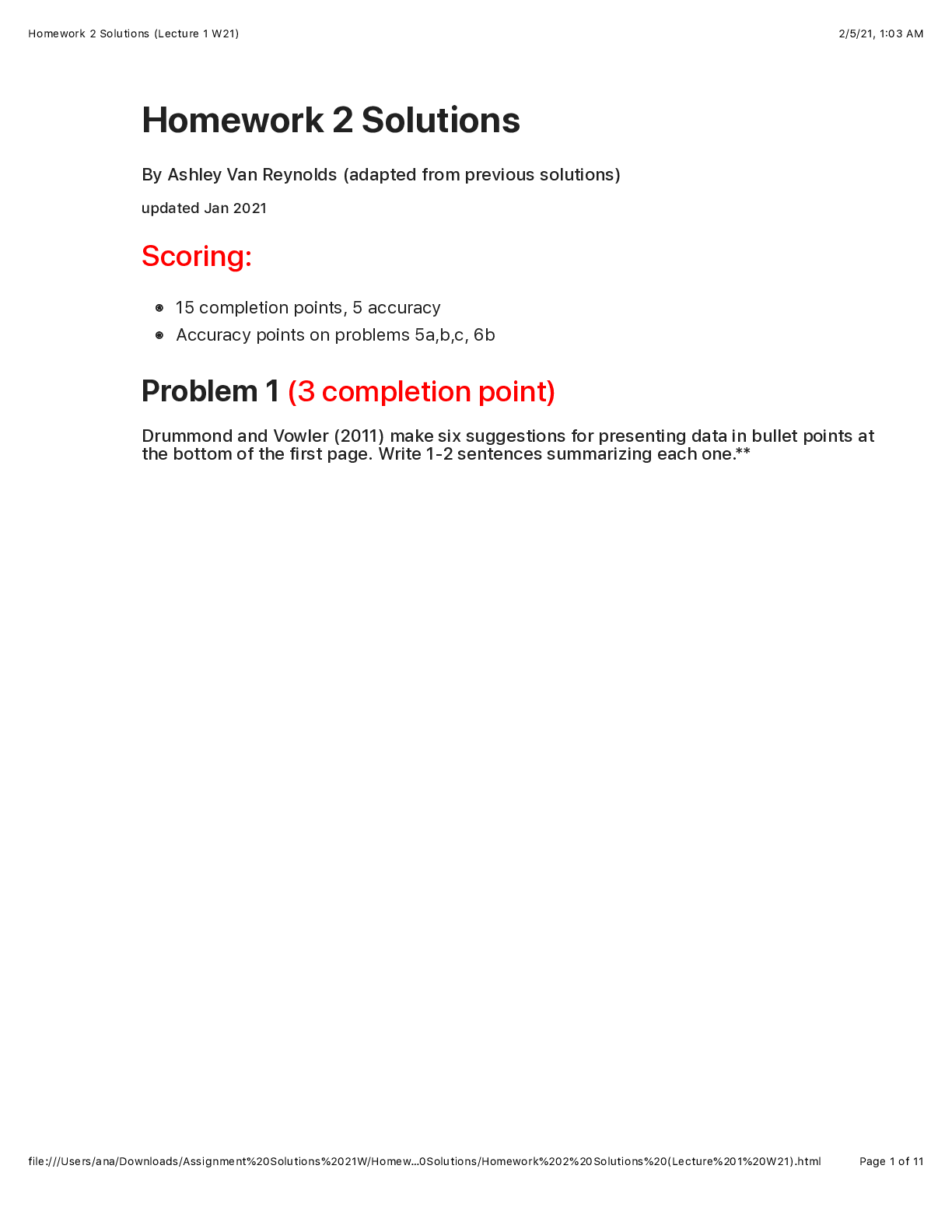Biological Psychology > QUESTIONS & ANSWERS > LS 40 (Life Science) Homework 7 Solutions (Lecture 1 W21)updated in Jan 2021 (All)
LS 40 (Life Science) Homework 7 Solutions (Lecture 1 W21)updated in Jan 2021
Document Content and Description Below
Homework 7 Solutions Adapted by Ashley Van Reynolds from previous solutions updated on March 2021 by Ana Gomez Scoring: 40 points total: Completion Points: 21, Accuracy Points: 19, on all problems... except 5 & 6 1. Program a function for (“chi-abs”) and use to repeat the PrEP |expected −observed| analysis you did in lab. Are the results of the two analyses consistent? 2 completion points, 2 accuracy points As given in Lab 7, the data is: Drug Placebo Infected 36 64 Not Infected 1215 1184 In [4]: import numpy as np import seaborn as sns import pandas as pd import matplotlib.pyplot as plt |χ| = ∑ expected − observed expected In [2]: # Define chi-abs function # Purpose: compute chi-abs for any arrays of observed and expected data # Inputs: 2 arrays of same dimensions (observed, expected data for same study) # Outputs: chi-abs value def chi_abs(obs, exp): result=np.sum((np.abs(obs-exp))/exp) return result In [5]: # From Lab 7: # Enter observed data obs = np.array([[36, 64], [1215, 1184]]) # Calculate column totals total_drug = np.sum(obs[:,0]) # sum column 0 total_placebo = np.sum(obs[:,1]) # sum column 1 3/7/2021 Homework 7 Solutions (Lecture 1 S20) file:///home/user/Assignment%20Solutions%2021W/Homework%20Solutions/Homework%207%20Solutions%20(Lecture%201%20… 2/12 array([[ 50.06002401, 49.93997599], [1200.93997599, 1198.06002401]]) 0.0088 # Calculate row totals total_infected = np.sum(obs[0,:]) # sum row 0 total_uninfected = np.sum(obs[1,:]) # sum row 1 # Calculate total number of patients n = np.sum(obs) # Expected value is (sum of row )/n x (sum of column) # For example, overall probability of infection = total_infected/n, #so number of expected patients with drug & infected = #overall probability of infection * # of patients with drug # = total_infected/n*total_drug expected = np.array([[total_infected/n*total_drug, total_infected/n*total_placebo], [total_uninfected/n*total_drug, total_uninfected/n*total_placebo]]) expected Out[5]: In [9]: # Perform 10,000 simulations and calculate p-value #(same as in Lab 7, but calculating chi-abs) obschiabs=chi_abs(obs, expected) results=np.zeros(10000) sim=np.zeros([2,2]) # Box combines all infected and uninfected from both drug and placebo groups #so each individual has same overall probability of infection for i in range(10000): box=["I"]*total_infected + ["NI"]*total_uninfected drug_resample=np.random.choice(box, total_drug) sim[0,0]=np.sum(drug_resample == "I") sim[1,0]=np.sum(drug_resample == "NI") placebo_resample = np.random.choice(box, total_placebo) sim[0,1]=np.sum(placebo_resample == "I") sim[1,1]=np.sum(placebo_resample == "NI") results[i]=chi_abs(sim, expected) p=sns.displot(results, kde=False) plt.axvline(obschiabs,color="mediumvioletred") count=np.sum(results >= obschiabs) pval=count/10000 pval # In Lab 7, we calculated a p-value using chi-squared of about 0.0178. # The results of the twoanalyses are fairly consistent, although we couldn't # reject the null hypothesis using chi-squared if alpha = 0.01. With a p-value # of 0.0088, we can definitely reject the null hypothesis and say that the drug # has a significant effect on the odds of being infected with HIV. # In combination with other research and expert opinions, we can recommend # that patients at risk of HIV infection use PrEP drugs. [Show More]
Last updated: 2 years ago
Preview 1 out of 12 pages

Buy this document to get the full access instantly
Instant Download Access after purchase
Buy NowInstant download
We Accept:

Reviews( 0 )
$11.00
Can't find what you want? Try our AI powered Search
Document information
Connected school, study & course
About the document
Uploaded On
Jul 09, 2021
Number of pages
12
Written in
Additional information
This document has been written for:
Uploaded
Jul 09, 2021
Downloads
0
Views
68


















